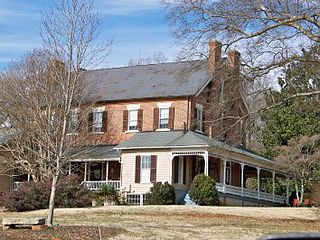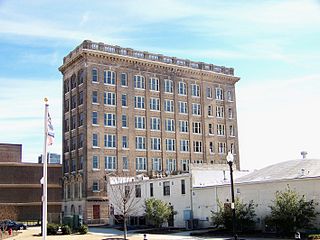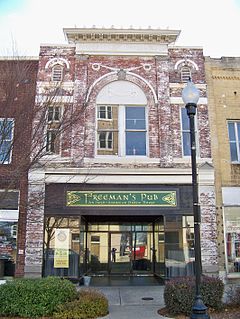
Gastonia is the largest city in and county seat of Gaston County, North Carolina, United States. It is the second-largest satellite city of the Charlotte area, behind Concord. The population was 71,741 at the 2010 Census. In 2019, the population had increased to 77,273. Gastonia is the 13th most populous city in North Carolina. It is part of the Charlotte metropolitan area, officially designated the Charlotte Metropolitan Statistical Area (MSA).

The Old North Carolina Mutual Life Insurance Company Building, also known as the Mechanics and Farmers Bank Building, is an office building at 114-116 West Parrish Street in downtown Durham, North Carolina. It formerly served as the headquarters for the North Carolina Mutual Life Insurance Company, one of the nation's largest companies founded and owned by African-Americans. The building was declared a National Historic Landmark in 1975.

The State Bank of North Carolina is the oldest surviving commercial building in Raleigh, North Carolina and was the first state-sponsored banking institution constructed in North Carolina. The bank was incorporated in 1810, but during the War of 1812 cash was moved inland to banks in Raleigh and Tarboro for fears that the British Army would attack the coast. The increase in money deposits resulted in the State Bank's construction in 1813. Jacob Johnson, the father of future President Andrew Johnson, was once employed at the bank. The building was listed on the National Register of Historic Places in 1970 and is a Raleigh Historic Landmark. It is located in the Capitol Area Historic District.

William Lee Stoddart (1868–1940) was an architect best known for designing urban hotels in the eastern United States. Although he was born in Tenafly, New Jersey, most of his commissions were in the South. He maintained offices in Atlanta and New York City.
Charles C. Wilson, whose full name is Charles Coker Wilson, was an American architect based in Columbia, South Carolina. Wilson was born in Hartsville, South Carolina, and graduated from South Carolina College with an engineering degree in 1886, continuing on to receive his master's degree in 1888. He briefly studied architecture in the Atelier Duray at the École des Beaux-Arts in Paris. Much of his work contained Beaux-Arts elements. Architects who worked for Wilson include Joseph F. Leitner, during 1901–1905, who became a noted architect in Wilmington, North Carolina; and Henry Ten Eyck Wendell, during 1905–1906.

Atlantic Bank and Trust Company Building, also known as the North Carolina National Bank Building, is a historic bank building located in Burlington, Alamance County, North Carolina. It was designed by architect Charles C. Hartmann and built in 1928–1929. It is a nine-story, steel-framed midrise in the Art Deco style. It features rich granite ornamentation at the bottom and top pairs of stories.

Milton State Bank, also known as the Branch Bank of the Bank of the State of North Carolina at Milton, is a historic bank building located at Milton, Caswell County, North Carolina. It was built in 1860, and is a two-story, three bay by five bay, Greek Revival style brick building. It housed a bank on the first floor and residential unit on the second. It housed a bank until about 1914. From about 1914 to 1963 the building served as a combination residence and the Milton Post Office. It was subsequently converted to residential usage.

Historic Cleveland County Courthouse is a courthouse building located at Shelby, Cleveland County, North Carolina.

Gastonia High School is a historic high school building located at Gastonia, Gaston County, North Carolina. It was designed by Hugh Edward White and built in 1922–1924. It is a five-story, heavily ornamented "E"-shaped Tudor Revival style red brick school. It has a flat roof with parapet and features a four-bay projecting frontispiece and two-story, elegantly finished, auditorium. It has a six bays long and three bays wide addition built in 1955.

William J. Wilson House is a historic home located near Gastonia, Gaston County, North Carolina. It was built about 1824, and is a two-story, five bay, Federal style frame dwelling. It has a side-gable roof and exterior brick end chimneys. It features a one-story, Late Victorian porch with porte cochere.

Gaston County Courthouse is a historic courthouse building located at Gastonia, Gaston County, North Carolina. It was designed by Milburn, Heister & Company in 1909 and built in 1910. It is a three-story, rectangular, Classical Revival style tan brick building with a rear addition. It features pedimented porticoes supported by Ionic order columns, a heavy modillion and dentil cornice, and three-sided pavilions on the side elevations. The building was renovated in 1954.

First National Bank Building, also known as the Lawyers Building, is a historic office building located at Gastonia, Gaston County, North Carolina. It was designed by Wilson & Sompayrac and built in 1916–1917. It is a seven-story, rectangular, Classical Revival style steel frame building. It is sheathed in cream-colored brick with limestone and terra cotta trim.

Robinson–Gardner Building, also known as the Robinson Brothers Building, is a historic commercial building located at Gastonia, Gaston County, North Carolina. It was built in 1899, and is a two-story, three bay, brick building with Renaissance Revival style design elements. The second story of the front facade features a round arch with a decorative cartouche at the keystone position and terra cotta swirls at the bases. Within the arch is a pressed metal swag between a pair of ribboned wreaths pierced by vertical torches. Above the arch, pressed metal wreaths hold another, larger, metal swag.

David Jenkins House was a historic home located at Gastonia, Gaston County, North Carolina. It was built about 1876–1877, and was a two-story, three bay, frame farmhouse with Greek Revival and Italianate style design elements. It featured a low hip roof supported by ornamental brackets. It was built by David A. Jenkins (1822–1886), a Republican politician and North Carolina State Treasurer from 1868 until 1876. The house has been demolished.

Craig Farmstead is a historic home and farm located near Gastonia, Gaston County, North Carolina. The William Moore Craig House was built about 1852, and is a one-story, single pile, two-room hewn- and sawn-frame house. The William Newton Craig House was built in 1886, and is a two-story, single pile Italianate style frame dwelling. Also on the property are the contributing privy, meat / well house, frame barn, rectangular log pen barn, and corn crib.

Downtown Gastonia Historic District is a national historic district located at Gastonia, Gaston County, North Carolina. It encompasses 77 contributing buildings and 1 contributing object in the central business district of Gastonia. The commercial, civic, institutional, and multi-unit residential buildings were built between the 1890s and 1954, and include notable examples of Colonial Revival and Classical Revival architecture. Located in the district are the separately listed former Gaston County Courthouse, First National Bank Building, Third National Bank Building, and Robinson-Gardner Building. Other notable buildings include the U.S. Post Office (1935), York Medical Building (1938), Kress Department Store, Leibowitz Department Store, Ideal Moving Picture Theater, City Hall, Kirby Building (1922), First Baptist Church (1922), Gaston County War Memorial Hall (1928), and the (former) Gaston County Public Library (1930).

York-Chester Historic District is a national historic district located at Gastonia, Gaston County, North Carolina. It encompasses 649 contributing buildings, 2 contributing sites, and 1 contributing structure in a predominantly residential section of Gastonia. The dwellings were built between about 1856 and 1955, and include notable examples of Queen Anne and Bungalow / American Craftsman architecture. Located in the district are the separately listed former Gastonia High School. Other notable contributing resources include the Beal-Ragan Garden, Oakwood Cemetery, Caroline Hanna House, Spurrier Apartment building, Edgewood Apartments, and Devant J. and June S. Purvis House (1951).

Loray Mill Historic District is a national historic district located at Gastonia, Gaston County, North Carolina. It encompasses 649 contributing buildings, 2 contributing sites, and 1 contributing structure in a predominantly residential section of Gastonia. The district includes the five-story brick Loray Mill and all or parts of some thirty blocks of frame mill houses constructed primarily between the early 1900s and the 1920s. They include notable examples of Colonial Revival, Gothic Revival, and Bungalow / American Craftsman architecture. Other notable buildings include the Loray Baptist Church (1952).

City Hospital-Gaston Memorial Hospital is a historic hospital complex located at Gastonia, Gaston County, North Carolina. The complex consists of: the 1924 Classical Revival style City Hospital designed by architect Charles Coker Wilson; the 1951 Gaston Memorial Hospital; the 1957 addition that connects them; and a 1947 nurses’ school and dormitory. The original section is a four-story, 12 bay by 3 bay, brick building.



















